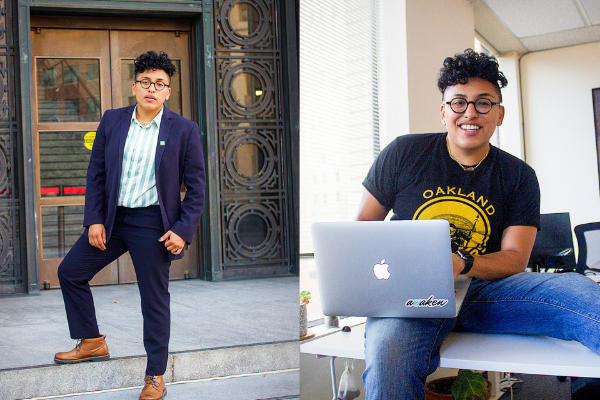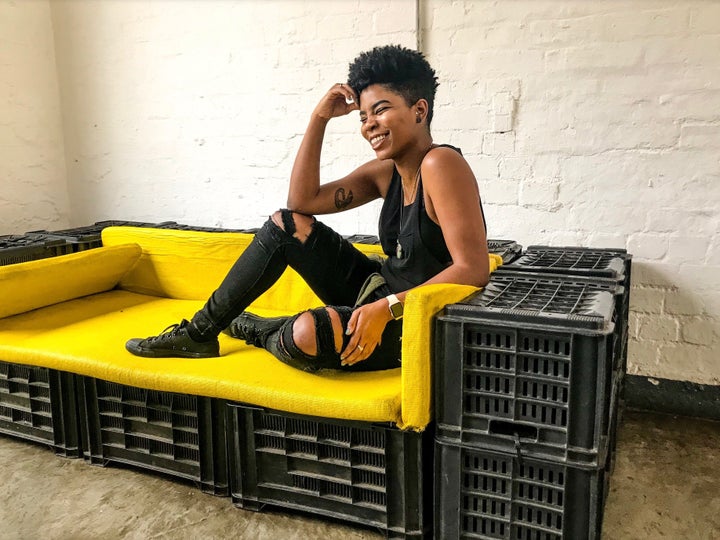The Problematic Politics Of Style And Gender Identity In The Workplace
Doreen Pierre
09/13/2019
Queer. Black. Woman. Nonbinary. Masculine. Feminine. Those are all parts of myself that I’ve embodied throughout my life but could never fully grasp at once.
Most of the time, they felt like pieces that I should pick up, put down, shift, express or hide in order to show up as a version of myself that people around me could easily digest. It took me years to come out as queer to my strict, religious, Haitian mother out of fear of rejection. I secretly started experimenting with dapper masculine clothing during college but came home on weekends and wore dresses she bought as I accompanied her to church services.
I finally found the courage to come out to my mom after graduation when I moved to New York City. I moved in with my partner at the time and started blogging about fashion and gender identity — but couldn’t figure out what I would wear to work as a budding human resources professional.
As an HR student, I had learned that dress codes are often used as a way of maintaining a standard level of visual professionalism. But I also knew how much sexism, anti-blackness and repression of gender identities outside of cisgender-heteronormative standards are woven into many of these policies.

COURTESY OF DOREEN PIERRE
Bringing my full self to work would mean being the only black, masculine-presenting woman in my office, who wore button downs, vests and slacks. I was a wrench thrown in the master’s plan, and I had to be prepared for what could come my way because of it. I saw it in the subtle ways that I was treated when my hair was long and straightened versus natural, kinky and tapered. My co-workers lit up every time they saw my straightened hair. The more relatable and “professional” my appearance was to my white counterparts, the more opportunities I got.
AN ESSENTIAL DAILY GUIDE TO ACHIEVING THE GOOD LIFE
I noticed this cluelessness and inability to assess the deeper context of what it means to be inclusive again when I embraced my dapper style at work. A supervisor of mine clumsily changed the dress code policy to be more inclusive of gender neutral and masculine clothing options for women, but failed to include any feminine clothing or accessories for any men, nonbinary folk or trans-women that would need them.
Stories like mine aren’t outliers and have sparked law changes like the Crown Act, which aims to protect black employees and students from hair discrimination in California. And most recently, plaintiff Aimee Stephens has been at the center of a Supreme Court case after she was fired for coming out as a trans woman at work. The decision will be pivotal for members of the LGBTQ community who are disadvantaged for not wanting to — or not having the luxury of — blending in.
I talked to seven queer folks on how they’ve shown up as their full selves at work and what they’ve navigated because of it.

Kay Martinez
Pronouns and gender identity: they/them/theirs, gender non-conforming
Age: 34
Current occupation: Facilitator and content creator, Awaken, a firm that consults on diversity, equity and inclusion matters
I love wearing suits when I lead presentations for clients, but it’s not required. I do it for myself. Having tailored suits helps me when I’m struggling with gender dysmorphia because my clothes are made to fit my body. On days that I dress down I’m usually in a T-shirt, jeans and a pair of sneakers. I tie this all together with my mom’s gold nameplate that never leaves my neck. It says “Cecibel,” which is her given name. She changed it when she became a naturalized U.S. citizen, so I keep it to remind myself where I come from and to resist assimilation.
“I’d never felt like my gender identity and expression were truly respected or empowered in any workplace.”
Prior to my current role as a consultant with Awaken, I’d never felt like my gender identity and expression were truly respected or empowered in any workplace. My style is “androgynous,” meaning that it’s a combination of what people consider traditionally masculine and feminine. While it’s passé, I’m a “cross-dresser” in that I wear clothes from across the store, which often comes with consequences.
Any negative issues I’ve had in the workplace regarding my gender are remnants of gender policing and enforcing a gender binary. I’ve often been misgendered and questioned or feared — sometimes to the point of threats to call the police in “women’s” bathrooms. Additionally, the combination of my gender variant clothing, pronoun usage, age and high-level job has resulted in folks questioning my authority and credentials. People have policed my tone of voice, saying it’s too aggressive or “not feminine enough.” I’m glad that I work for Awaken’s CEO, Michelle Kim, a queer woman who created a trans-inclusive workplace and really does the work to educate herself on current social issues.

Trent
Pronouns and gender identity: she/her/they/them, gender non-conforming/gender nonbinary
Age: 32
Current occupation: Flight attendant on a major airline. (We’ve omitted a photo of Trent in their flight attendant uniform for confidentiality reasons.)
When I first began working for the airline, I wore the female-assigned uniform kit. I stuck with the more gender neutral pieces ― pants, collared shirt or turtleneck, vest and blazer ― and chose not to wear the dress option.
Recently, when the airline did a complete overhaul and changed over to a new uniform, I wasn’t satisfied. The pieces in the new uniform were meant to look definitively more feminine than before. One of the blazers and sweater were both peplum styled. The new button-up had a fly-away leaflet collar and the vests were short fitting. On our first day wearing the new uniform, someone showed me a picture of another plane crew and I noticed a female-bodied person wearing the male uniform. Up until that point, I had no idea that was an option.
I emailed my supervisor to inform him that I wanted to swap my uniform from the female kit to the male kit. I was directed to a link on our company website to fill out a “uniform exception request” form for approval. However, the link on the website was dead. It took two weeks to get a working link — and then I was shuffled between my supervisor, our uniforms department, our distributor and our accommodations department for two months until I was finally able to get approved for the male uniform.
One male-bodied person has asked me, “So are you wearing that for attention?” Another said, “I think it’s unfair that females get to order the male uniform because it’s putting all my sizes on back order.” Many of my co-workers make it a point to tell me I look good in it, which I don’t mind, but I know I get more attention than I would if I wore the female-assigned uniform. But I just wanted to wear something that felt comfortable and true to me.
Load older comments...
Loading comments...
You've Been Timed Out
Please login to continue